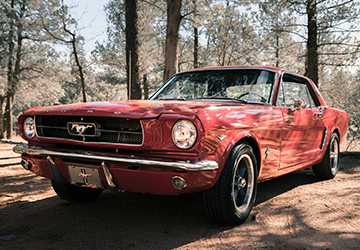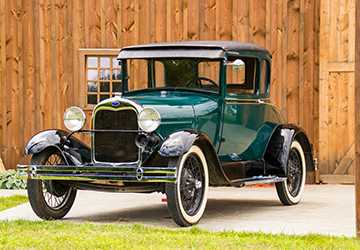Have you ever dreamed of owning beautiful vintage cars? Does the idea of driving an elegant antique vehicle down the road thrill you? If so, you’re not alone. Vintage vehicles capture the imagination with their unique styling and nostalgic charm.
But if you’re just getting started with antique auto collecting, it can feel overwhelming. Where do you find them? How much do they cost? What problems crop up with older vehicles?
Not to worry. We’re here to help with five essential tips for correctly beginning your vintage car collection. Let’s hit the road!
Vintage Car Collecting Isn’t Always Easy...But It’s Worth It
We get it. Those gorgeous classics parked at auctions and speciality shows spark adventure in your heart. You picture breezing along country roads with the top down, not a care in the world.
But vintage cars require more TLC than modern ones. Parts wear out, repairs add up, and rust never sleeps. Without dedication, your collectable risks becoming a neglected “barn find” rusting away instead of a gleaming gem.
Stick with it, though, and owning a unique slice of automotive history offers rewards modern metal can’t match. You join a unique community of those who value craftsmanship and style. And nothing beats the wave of a passerby who appreciates your ride.
Put in the work; that vintage beauty will pay you back for decades. Now, let’s get you started, right?

Tip 1: Define Your Collection’s Focus Early
With so many incredible classics out there, it helps to narrow your search from the beginning. Seeking out any cool old car that catches your eye leads to a random assortment that’s difficult to maintain.
Instead, focus your collection around a theme:
● Specific Make or Model: Only Cadillacs, Mustangs or Bel Airs, for example
● Era: 1950s finned wonders, graceful early 60s curves, etc.
● Type: Sporty roadsters, substantial luxury vehicles, iconic muscle cars
● Condition: Show-quality restored masterpieces or wear-showing “survivors”
Defining a direction provides boundaries for your burgeoning fleet. This gives you a purpose when searching auctions, dealerships and classifieds. Over time, your focused collection gains a meaningful, cohesive identity.
Tip 2: Join Early Model-Specific Owner’s Communities
Congrats, you scored an incredible deal on that 1964 Impala SS you’ve always wanted! But now what? 50-year-old vehicles need specialized care to stay roadworthy. Replacement parts can be scarce. And some repairs require techniques modern shops don’t know.
Connecting early with make/model-specific owners’ groups is essential. These brand enthusiasts share hard-earned knowledge on keeping their vehicles running strong. They also know where to find parts, trusted mechanics and model-savvy restorers when needed.
Join forums and enthusiast message boards related to your chosen focus vehicle. Attend meetings and events to connect face-to-face. Knowing the right people makes all the difference in keeping your new baby humming down the highway instead of being stuck in the garage.
Tip 3: Set a Restoration Budget...Then Double It
You excitedly tow home that iconic classic you discovered listed for a shockingly low buy-it-now price. In your mind’s eye, you already picture its dramatic unveiling after a quick trip to the body shop for some buffing and touch-up paint...
Back in reality, restoration costs add up fast. Addressing wear and corrosion on 50+-year-old vehicles often snowballs into a nearly complete rebuild.
Before you start any restoration project, carefully consider potential expenses. Research what parts cost and typical shop rates in your area. Compile estimates from trusted restorers.
Then, take your budget total and double it, minimum. Vintage vehicles often hide damaging rust or rot in hidden areas only discovered after disassembly. Unexpected overruns easily wreck budgets and dreams without ample financial padding.
If costs still look intimidating even after doubling, consider choosing a less deteriorated project car or “survivor” to enjoy as-is. The right mindset prevents vintage car frustration.

Tip 4: Garage Your Investment Properly
You found a Cherry Sunday Driver Classic that starts instantly and purrs down the road. The interior looks nearly showroom-fresh. Why lock it away when there’s open cruising to enjoy?
Beware of the temptation of using your collectables as daily transportation. Exposing vintage sheet metal and components to harsh weather and heavy use accelerates wear. Pristine vehicles decline into beaters quicker than expected.
Store your unique rides in enclosed, climate-controlled garages whenever possible. Limit driving to lovely days for enjoyment only. Transport securely with enclosed trailers rather than risky open carriers.
Follow collector car storage best practices, and that gleaming beauty stays in peak condition. Your investment retains maximum value while staying safe for future fun. Use modern daily drivers to handle mundane transportation duties.
Tip 5: Research, Research, Research!
Reading guides like this marks a promising start to entering vintage car collecting. But there’s no substitute for tireless first-hand research before purchasing any collector vehicle.
Scour enthusiast forums are seeking known trouble spots for your targeted models. Study finished auction listings to learn actual current values. Pore over parts supplier catalogues to understand repair costs.
Check out local and regional car clubs to examine conditions and chat with experienced owners. Attend cruise-ins and shows examining your dream cars up close.
The more familiar you become with your focus vehicle’s strengths, flaws, and tricks before buying, the less likely expensive surprises will follow you home. Do your homework, and start your collection confidently!
Let Your Vintage Adventure Begin!
We get it. That siren song of classic metal beckons you toward open roads under boundless skies. It’s irresistible!
But balance that wanderlust with practical planning and understanding. Follow these collected tips from veteran collectors, and you’ll keep your dream machines running smoothly for years instead of sitting neglected.
Vintage cars endure because of those who value their legacy. Now celebrate these unique machines, and happy motoring!





